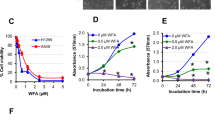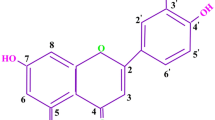Abstract
Since epithelial-mesenchymal transition (EMT) plays a critical role in cancer progression and in maintaining cancer stem cell properties, EMT is emerging as a therapeutic target for inhibiting the metastatic progression of cancer cells. 2′-Hydroxycinnamaldehyde (HCA) and its derivative, 2′-benzoyloxycinnamaldehyde, have recently been suggested as promising therapeutic candidates for cancer treatment. The purpose of this study is to investigate the anti-metastatic effect of HCA on breast cancer and the molecular mechanisms by which HCA regulates the transcriptional program during EMT. HCA induces epithelial reversion at nanomolar concentrations by suppressing Snail via the nuclear translocalization of GSK-3β, which results in the transcriptional upregulation of E-cadherin. HCA also activates the transcription factor KLF17, which suppresses Id-1, indicating that HCA inhibits EMT by multiple transcriptional programs. Further, HCA treatment significantly inhibits lung metastasis in a mouse orthotopic breast cancer model. This study demonstrates the anti-metastatic effect of the non-toxic natural compound HCA through attenuation of EMT in a breast cancer model.







Similar content being viewed by others
References
Kwon BM, Cho YK, Lee SH, Nam JY, Bok SH, Chun SK et al (1996) 2′-Hydroxycinnamaldehyde from stem bark of cinnamomum cassia. Planta Med 62:183–184
Han DC, Lee MY, Shin KD, Jeon SB, Kim JM, Son KH et al (2004) 2′-benzoyloxycinnamaldehyde induces apoptosis in human carcinoma via reactive oxygen species. J Biol Chem 279:6911–6920
Kwon BM, Lee SH, Choi SU, Park SH, Lee CO, Cho YK et al (1998) Synthesis and in vitro cytotoxicity of cinnamaldehydes to human solid tumor cells. Arch Pharm Res 21:147–152
Lee CW, Hong DH, Han SB, Park SH, Kim HK, Kwon BM et al (1999) Inhibition of human tumor growth by 2′-hydroxy- and 2′-benzoyloxycinnamaldehydes. Planta Med 65:263–266
Moon EY, Lee MR, Wang AG, Lee JH, Kim HC, Kim HM et al (2006) Delayed occurrence of H-ras12V-induced hepatocellular carcinoma with long-term treatment with cinnamaldehydes. Eur J Pharmacol 530:270–275
Lee K, Kwon BM, Kim K, Ryu J, Oh SJ, Lee KS et al (2009) Plasma pharmacokinetics and metabolism of the antitumour drug candidate 2′-benzoyloxycinnamaldehyde in rats. Xenobiotica 39:255–265
Steeg PS (2006) Tumor metastasis: mechanistic insights and clinical challenges. Nat Med 12:895–904
Steeg PS (2007) Cancer: micromanagement of metastasis. Nature 449:671–673
Eccles SA, Welch DR (2007) Metastasis: recent discoveries and novel treatment strategies. Lancet 369:1742–1757
Zhou BB, Zhang H, Damelin M, Geles KG, Grindley JC, Dirks PB (2009) Tumour-initiating cells: challenges and opportunities for anticancer drug discovery. Nat Rev Drug Discov 8:806–823
Sreekumar R, Sayan BS, Mirnezami AH, Sayan AE (2011) MicroRNA Control of Invasion and Metastasis Pathways. Front Genet 2:58
Nieto MA (2002) The snail superfamily of zinc-finger transcription factors. Nat Rev Mol Cell Biol 3:155–166
Xu C, Kim NG, Gumbiner BM (2009) Regulation of protein stability by GSK3 mediated phosphorylation. Cell Cycle 8:4032–4039
Lim SO, Kim H, Jung G (2010) p53 Inhibits tumor cell invasion via the degradation of snail protein in hepatocellular carcinoma. FEBS Lett 584:2231–2236
Kim NH, Kim HS, Li XY, Lee I, Choi HS, Kang SE et al (2011) A p53/miRNA-34 axis regulates Snail1-dependent cancer cell epithelial-mesenchymal transition. J Cell Biol 195:417–433
Zannetti A, Del Vecchio S, Romanelli A, Scala S, Saviano M, Cali G et al (2005) Inhibition of Sp1 activity by a decoy PNA-DNA chimera prevents urokinase receptor expression and migration of breast cancer cells. Biochem Pharmacol 70:1277–1287
Hung WC, Chang HC (2009) Indole-3-carbinol inhibits Sp1-induced matrix metalloproteinase-2 expression to attenuate migration and invasion of breast cancer cells. J Agric Food Chem 57:76–82
Jorda M, Vinyals A, Marazuela A, Cubillo E, Olmeda D, Valero E et al (2007) Id-1 is induced in MDCK epithelial cells by activated Erk/MAPK pathway in response to expression of the Snail and E47 transcription factors. Exp Cell Res 313:2389–2403
Zhang X, Ling MT, Wang Q, Lau CK, Leung SC, Lee TK et al (2007) Identification of a novel inhibitor of differentiation-1 (ID-1) binding partner, caveolin-1, and its role in epithelial-mesenchymal transition and resistance to apoptosis in prostate cancer cells. J Biol Chem 282:33284–33294
Fong S, Itahana Y, Sumida T, Singh J, Coppe JP, Liu Y et al (2003) Id-1 as a molecular target in therapy for breast cancer cell invasion and metastasis. Proc Natl Acad Sci USA 100:13543–13548
Darnel AD, Wang D, Ghabreau L, Yasmeen A, Sami S, Akil N et al (2010) Correlation between the presence of high-risk human papillomaviruses and Id gene expression in Syrian women with cervical cancer. Clin Microbiol Infect 16:262–266
Ding Y, Wang G, Ling MT, Wong YC, Li X, Na Y et al (2006) Significance of Id-1 up-regulation and its association with EGFR in bladder cancer cell invasion. Int J Oncol 28:847–854
Li B, Tsao SW, Li YY, Wang X, Ling MT, Wong YC et al (2009) Id-1 promotes tumorigenicity and metastasis of human esophageal cancer cells through activation of PI3K/AKT signaling pathway. Int J Cancer 125:2576–2585
Cheung PY, Yip YL, Tsao SW, Ching YP, Cheung AL (2011) Id-1 induces cell invasiveness in immortalized epithelial cells by regulating cadherin switching and Rho GTPases. J Cell Biochem 112:157–168
Gumireddy K, Li A, Gimotty PA, Klein-Szanto AJ, Showe LC, Katsaros D et al (2009) KLF17 is a negative regulator of epithelial-mesenchymal transition and metastasis in breast cancer. Nat Cell Biol 11:1297–1304
Mani SA, Guo W, Liao MJ, Eaton EN, Ayyanan A, Zhou AY et al (2008) The epithelial-mesenchymal transition generates cells with properties of stem cells. Cell 133:704–715
Gupta PB, Onder TT, Jiang G, Tao K, Kuperwasser C, Weinberg RA et al (2009) Identification of selective inhibitors of cancer stem cells by high-throughput screening. Cell 138:645–659
Cabello CM, Bair WB 3rd, Lamore SD, Ley S, Bause AS, Azimian S et al (2009) The cinnamon-derived Michael acceptor cinnamic aldehyde impairs melanoma cell proliferation, invasiveness, and tumor growth. Free Radic Biol Med 46:220–231
Liang CC, Park AY, Guan JL (2007) In vitro scratch assay: a convenient and inexpensive method for analysis of cell migration in vitro. Nat Protoc 2:329–333
Yook JI, Li XY, Ota I, Hu C, Kim HS, Kim NH, Cha SY, Ryu JK, Choi YJ, Kim J, Fearon ER, Weiss SJ (2006) A Wnt-Axin2-GSK3beta cascade regulates Snail1 activity in breast cancer cells. Nat Cell Biol 8:1398–1406
Livak KJ, Schmittgen TD (2001) Analysis of relative gene expression data using real-time quantitative PCR and the 2(-Delta Delta C(T)) method. Methods 25:402–408
Fan J, Ren H, Fei E, Jia N, Ying Z, Jiang P et al (2008) Sumoylation is critical for DJ-1 to repress p53 transcriptional activity. FEBS Lett 582:1151–1161
Lo HW, Hsu SC, Xia W, Cao X, Shih JY, Wei Y, Abbruzzese JL, Hortobagyi GN, Hung MC (2007) Epidermal growth factor receptor cooperates with signal transducer and activator of transcription 3 to induce epithelial-mesenchymal transition in cancer cells via up-regulation of TWIST gene expression. Cancer Res 67:9066–9076
Vergara D, Valente CM, Tinelli A, Siciliano C, Lorusso V, Acierno R, Giovinazzo G, Santino A, Storelli C, Maffia M (2011) Resveratrol inhibits the epidermal growth factor-induced epithelial mesenchymal transition in MCF-7 cells. Cancer Lett 310:1–8
Weigelt B, Peterse JL, van ‘t Veer LJ (2005) Breast cancer metastasis: markers and models. Nat Rev Cancer 5:591–602
Arias AM (2001) Epithelial mesenchymal interactions in cancer and development. Cell 105:425–431
Ren Z, Kang YH, Shi ZY, Huang-Fu CS, Hu GQ, Liu B (2010) Cinnamaldehyde of loxacin-3-ylhydrazone induces apoptosis of human hepatocarcinoma SMMC-7721 cells. Yao Xue Xue Bao 45:1109–1115
Kwon HK, Hwang JS, So JS, Lee CG, Sahoo A, Ryu JH et al (2010) Cinnamon extract induces tumor cell death through inhibition of NFkappaB and AP1. BMC Cancer 10:392
Lee CW, Lee SH, Lee JW, Ban JO, Lee SY, Yoo HS et al (2007) 2-Hydroxycinnamaldehyde inhibits SW620 colon cancer cell growth through AP-1 inactivation. J Pharmacol Sci 104:19–28
Ka H, Park HJ, Jung HJ, Choi JW, Cho KS, Ha J et al (2003) Cinnamaldehyde induces apoptosis by ROS-mediated mitochondrial permeability transition in human promyelocytic leukemia HL-60 cells. Cancer Lett 196:143–152
Koppikar SJ, Choudhari AS, Suryavanshi SA, Kumari S, Chattopadhyay S, Kaul-Ghanekar R (2010) Aqueous cinnamon extract (ACE-c) from the bark of Cinnamomum cassia causes apoptosis in human cervical cancer cell line (SiHa) through loss of mitochondrial membrane potential. BMC Cancer 10:210
Lu J, Zhang K, Nam S, Anderson RA, Jove R, Wen W (2010) Novel angiogenesis inhibitory activity in cinnamon extract blocks VEGFR2 kinase and downstream signaling. Carcinogenesis 31:481–488
Liu L, Hudgins WR, Shack S, Yin MQ, Samid D (1995) Cinnamic acid: a natural product with potential use in cancer intervention. Int J Cancer 62:345–350
Ouwehand K, Santegoets SJ, Bruynzeel DP, Scheper RJ, de Gruijl TD, Gibbs S (2008) CXCL12 is essential for migration of activated Langerhans cells from epidermis to dermis. Eur J Immunol 38:3050–3059
Ko H, Kim HS, Kim NH, Lee SH, Kim KH, Hong SH et al (2007) Nuclear localization signals of the E-cadherin transcriptional repressor Snail. Cells Tissues Organs 185:66–72
Yook JI, Li XY, Ota I, Fearon ER, Weiss SJ (2005) Wnt-dependent regulation of the E cadherin repressor snail. J Biol Chem 280:11740–11748
Yang Z, Rayala S, Nguyen D, Vadlamudi RK, Chen S, Kumar R (2005) Pak1 phosphorylation of snail, a master regulator of epithelial-to-mesenchyme transition, modulates snail’s subcellular localization and functions. Cancer Res 65:3179–3184
Hardy KM, Booth BW, Hendrix MJ, Salomon DS, Strizzi L (2010) ErbB/EGF signaling and EMT in mammary development and breast cancer. J Mammary Gland Biol Neoplasia 15:191–199
Gan Y, Shi C, Inge L, Hibner M, Balducci J, Huang Y (2010) Differential roles of ERK and Akt pathways in regulation of EGFR-mediated signaling and motility in prostate cancer cells. Oncogene 29:4947–4958
Cai Z, Zhou Y, Lei T, Chiu JF, He QY (2009) Mammary serine protease inhibitor inhibits epithelial growth factor-induced epithelial-mesenchymal transition of esophageal carcinoma cells. Cancer 115:36–48
Li J, Jia H, Xie L, Wang X, He H, Lin Y, Hu L (2009) Correlation of inhibitor of differentiation 1 expression to tumor progression, poor differentiation and aggressive behaviors in cervical carcinoma. Gynecol Oncol 114:89–93
Acknowledgments
This work was supported by the Basic Science Research Program through the National Research Foundation of Korea Grant funded by the Korean Government (2009-0070462). This research was supported by the Bio & Medical Technology Development Program of the National Research Foundation funded by the Korean government (2012M3A9C404877).
Disclosures
None.
Author information
Authors and Affiliations
Corresponding authors
Additional information
I. A. Ismail and H. S. Kang contributed equally to this work.
Electronic supplementary material
Below is the link to the electronic supplementary material.
10549_2012_2388_MOESM1_ESM.pdf
Relative cell invasion (a) and basal mRNA expression level changes in KLF17 (b), Sp1 (c), and Id-1 (d) after HCA treatment in non-metastatic (MCF-7, T47D) and metastatic (MDA-MB-231, MDA-MB-435) cells. These results are from three independent experiments and each bar represents standard deviation. (PDF 47 kb)
Rights and permissions
About this article
Cite this article
Ismail, I.A., Kang, H.S., Lee, HJ. et al. 2-Hydroxycinnamaldehyde inhibits the epithelial-mesenchymal transition in breast cancer cells. Breast Cancer Res Treat 137, 697–708 (2013). https://doi.org/10.1007/s10549-012-2388-7
Received:
Accepted:
Published:
Issue Date:
DOI: https://doi.org/10.1007/s10549-012-2388-7




